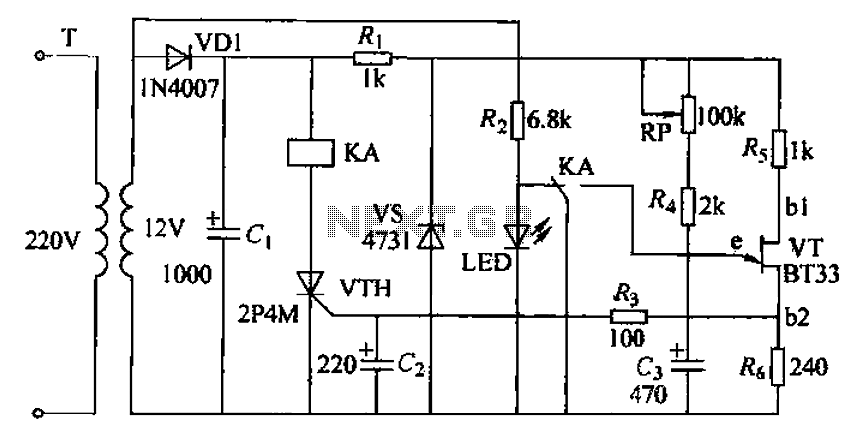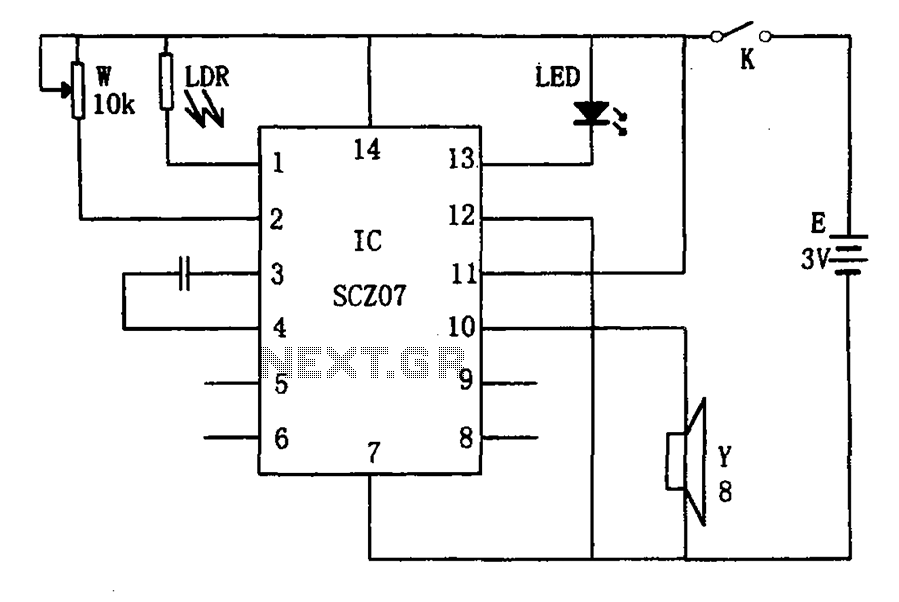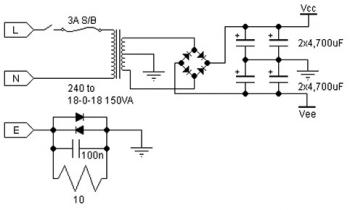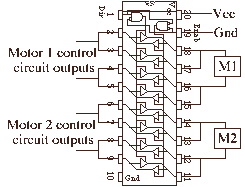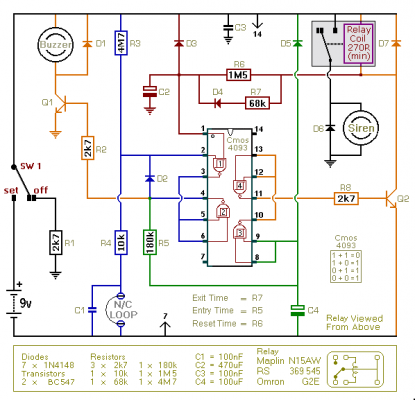
transistor based burglar alarm

This is a simple transistor-based burglar alarm circuit. Its features include automatic exit and entry delays, along with a timed bell cut-off and reset. It is designed to be used with common types of normally-closed input devices such as magnetic-reed contacts, micro switches, foil tape, and PIRs. The basic alarm has an "Exit/Entry" zone and an "Instant" zone, which is adequate for many situations. However, larger buildings are best divided into several smaller zones. The design allows for the addition of as many zones as desired to the basic system. These are "Instant Zones" and may be triggered by both normally-open and normally-closed input devices. The system is user-friendly; when the green LED is illuminated, the alarm can be activated using switch SW1. There is a 30-second window to exit the building. Upon returning and opening the door, the buzzer will sound, providing another 30 seconds to deactivate the alarm. If the alarm is not deactivated within this time frame, the siren will sound. The siren will continue to sound as long as at least one of the trigger switches remains open. However, if the trigger circuits are restored, the alarm will reset itself after approximately 10 minutes. The siren can be turned off at any time by deactivating the alarm. Due to manufacturing tolerances, the precise duration of any delay depends on the characteristics of the components used in the circuit. However, by adjusting the values of resistors R2, R7, and R9, the exit, entry, and reset times can be modified to meet specific requirements. Increasing these resistor values will extend the timing, while decreasing them will shorten it.
The transistor-based burglar alarm circuit is designed to provide a reliable security solution for residential and commercial applications. The core of the circuit consists of a transistor acting as a switch, which is triggered by various input devices. The circuit is equipped with both exit and entry delays to allow users to safely enter and exit the premises without triggering the alarm.
The alarm system features two distinct zones: the "Exit/Entry" zone and the "Instant" zone. The Exit/Entry zone is designed to provide a delay, giving users time to leave the premises after activating the system. Conversely, the Instant zone is configured to trigger the alarm immediately upon detection of unauthorized entry, ensuring rapid response to potential threats.
For larger installations, the ability to add multiple zones enhances the versatility of the alarm system. Each additional zone can be configured to respond to various types of input devices, including normally-open and normally-closed switches. This modular design allows for tailored security solutions that can adapt to the specific layout and requirements of larger buildings.
User interaction with the system is straightforward. The presence of a green LED indicator provides a visual confirmation that the system is armed. The activation process is initiated by engaging switch SW1, which starts the exit delay. During this time, users must exit the building, after which the system becomes fully operational.
Upon re-entry, the buzzer serves as an audible warning, indicating that the user has a limited time to deactivate the alarm before the siren is activated. The alarm's design ensures that it remains vigilant, continuing to sound until the triggering conditions are resolved. The automatic reset feature further enhances usability, allowing the system to restore itself after a predetermined period if the situation is rectified.
Adjustment of timing parameters is facilitated through the careful selection of resistor values. Resistors R2, R7, and R9 play a crucial role in determining the duration of exit, entry, and reset delays. By modifying these components, users can customize the alarm's response to fit their specific needs, accommodating variations in component tolerances and user preferences.
Overall, this transistor-based burglar alarm circuit is an effective and adaptable solution for enhancing security, providing users with flexibility and control over their alarm system.This is a simple transistor-based burglar alarm circuit. Its features include automatic Exit and Entry delays - together with a timed Bell cut-off and Reset. It`s designed to be used with the usual types of normally-closed input devices such as - magnetic-reed contacts - micro switches - foil tape - and PIRs. The basic alarm has an "Exit/Entry" zo ne and an "Instant" zone. This will be adequate in many situations. However - larger buildings are best divided into a number of smaller zones. The design allows you to Add As Many Zones As You Like to the basic system. They are "Instant Zones" - and may be triggered by both normally-open and normally-closed input devices. It`s easy to use. Make sure that the green LED is lighting - then switch the alarm on using Sw1. You have about 30 seconds to leave the building. When you return and open the door - the Buzzer will sound. You have about 30 seconds to switch off the alarm. If you fail to do so - the Siren will sound. While at least one of the trigger switches remains open - the Siren will continue to sound. However - if the trigger circuits have been restored - the alarm will reset itself after about 10 minutes.
Of course - you can turn the Siren off at any time by switching off the alarm. Because of manufacturing tolerances - the precise length of any delay depends on the characteristics of the actual components you`ve used in your circuit. But - to some degree - by altering the values of R2, R7 & R9 you can adjust the Exit, Entry and Reset times to suit your requirements.
Increasing the values increases the time - and vice-versa. 🔗 External reference
The transistor-based burglar alarm circuit is designed to provide a reliable security solution for residential and commercial applications. The core of the circuit consists of a transistor acting as a switch, which is triggered by various input devices. The circuit is equipped with both exit and entry delays to allow users to safely enter and exit the premises without triggering the alarm.
The alarm system features two distinct zones: the "Exit/Entry" zone and the "Instant" zone. The Exit/Entry zone is designed to provide a delay, giving users time to leave the premises after activating the system. Conversely, the Instant zone is configured to trigger the alarm immediately upon detection of unauthorized entry, ensuring rapid response to potential threats.
For larger installations, the ability to add multiple zones enhances the versatility of the alarm system. Each additional zone can be configured to respond to various types of input devices, including normally-open and normally-closed switches. This modular design allows for tailored security solutions that can adapt to the specific layout and requirements of larger buildings.
User interaction with the system is straightforward. The presence of a green LED indicator provides a visual confirmation that the system is armed. The activation process is initiated by engaging switch SW1, which starts the exit delay. During this time, users must exit the building, after which the system becomes fully operational.
Upon re-entry, the buzzer serves as an audible warning, indicating that the user has a limited time to deactivate the alarm before the siren is activated. The alarm's design ensures that it remains vigilant, continuing to sound until the triggering conditions are resolved. The automatic reset feature further enhances usability, allowing the system to restore itself after a predetermined period if the situation is rectified.
Adjustment of timing parameters is facilitated through the careful selection of resistor values. Resistors R2, R7, and R9 play a crucial role in determining the duration of exit, entry, and reset delays. By modifying these components, users can customize the alarm's response to fit their specific needs, accommodating variations in component tolerances and user preferences.
Overall, this transistor-based burglar alarm circuit is an effective and adaptable solution for enhancing security, providing users with flexibility and control over their alarm system.This is a simple transistor-based burglar alarm circuit. Its features include automatic Exit and Entry delays - together with a timed Bell cut-off and Reset. It`s designed to be used with the usual types of normally-closed input devices such as - magnetic-reed contacts - micro switches - foil tape - and PIRs. The basic alarm has an "Exit/Entry" zo ne and an "Instant" zone. This will be adequate in many situations. However - larger buildings are best divided into a number of smaller zones. The design allows you to Add As Many Zones As You Like to the basic system. They are "Instant Zones" - and may be triggered by both normally-open and normally-closed input devices. It`s easy to use. Make sure that the green LED is lighting - then switch the alarm on using Sw1. You have about 30 seconds to leave the building. When you return and open the door - the Buzzer will sound. You have about 30 seconds to switch off the alarm. If you fail to do so - the Siren will sound. While at least one of the trigger switches remains open - the Siren will continue to sound. However - if the trigger circuits have been restored - the alarm will reset itself after about 10 minutes.
Of course - you can turn the Siren off at any time by switching off the alarm. Because of manufacturing tolerances - the precise length of any delay depends on the characteristics of the actual components you`ve used in your circuit. But - to some degree - by altering the values of R2, R7 & R9 you can adjust the Exit, Entry and Reset times to suit your requirements.
Increasing the values increases the time - and vice-versa. 🔗 External reference

